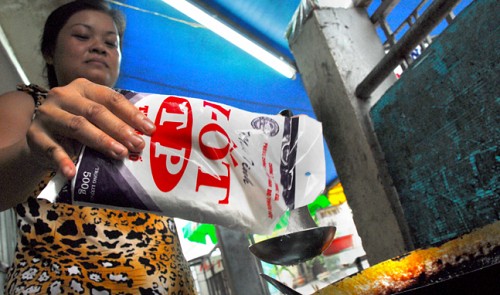Iodine Global Network (IGN)
Sprunglinks/Accesskeys
Zur Startseite (Accesskey 0) Direkt zur Hauptnavigation (Accesskey 1) Direkt zum Inhalt (Accesskey 2) Kontakt (Accesskey 3) Sitemap (Accesskey 4) Suche (Accesskey 5)
DONATE

Less than half Vietnam's population can get iodized salt

Seven years ago, 91.9 percent of Vietnamese households had access to iodized salt; today the rate is 46.1 percent, according to a survey conducted by the Central Urology Hospital. The results portray a pendulum-like swing: in 1992 only 6 percent of Vietnamese families had access to iodized salt which precipitated a massive salt iodization promotion.
Vietnam proclaimed IDD conquered in 2005 and terminated its salt iodization promotion in the hopes that the program was well-enough established to survive. The article speciously claims "the production of iodized salt requires advanced technology that few plants in Vietnam can obtain."
In 1993, 22.4 percent of Vietnamese children 8-12 had visible goiters. By 1998, that rate dropped to 14.2 percent and was again reduced in 2000 to 10.2 percent. At the conclusion of the iodized salt promotion in 2005, only 3.6 percent of children 8-12 had goiters; below the 5 percent standard of ICCIDD and global health authorities. The hospital is conducting further studies of health effects of iodine deficiency including mental retardation, stillbirths and miscarriages as well as learning difficulties for children.
Vietnam proclaimed IDD conquered in 2005 and terminated its salt iodization promotion in the hopes that the program was well-enough established to survive. The article speciously claims "the production of iodized salt requires advanced technology that few plants in Vietnam can obtain."
In 1993, 22.4 percent of Vietnamese children 8-12 had visible goiters. By 1998, that rate dropped to 14.2 percent and was again reduced in 2000 to 10.2 percent. At the conclusion of the iodized salt promotion in 2005, only 3.6 percent of children 8-12 had goiters; below the 5 percent standard of ICCIDD and global health authorities. The hospital is conducting further studies of health effects of iodine deficiency including mental retardation, stillbirths and miscarriages as well as learning difficulties for children.
